#Processor core IP
Explore tagged Tumblr posts
Text
Unique DSP (Digital Signal Processing) core projects For Final year Student
DSP (Digital Signal Processing) core projects are about using clever technology to make signals better. Takeoff Edu Group Furnishes DSP core Projects with better knowledge. It's like magic for sounds, images, and other signals. In these projects, people use special chips or software to make music sound better, pictures clearer, and even help computers understand speech. It's like having a digital wizard that makes things clearer and sharper. These projects are cool because they can make our phones, cameras, and other devices work even better. They give us clearer calls, nicer pictures, and smarter features.
Digital signal processing (DSP) Cores Projects are based on computers algorithms to manipulate the digital signals such as audio or video to give a meaningful output with respect to their content. The new projects are like digital toolboxes that can help you with almost any imaginable tasks like filtering the noise from audio, or cleaning the image, and always minimizing the data size to save storage. Can you assume that the individual is speaking to you via a medium that is not so clear? A project of the DSP would be helpful due to the fact that the audio is degraded and noise removal is the only way to hear the person's voice. Perhaps you could talk about an instance of image processing.
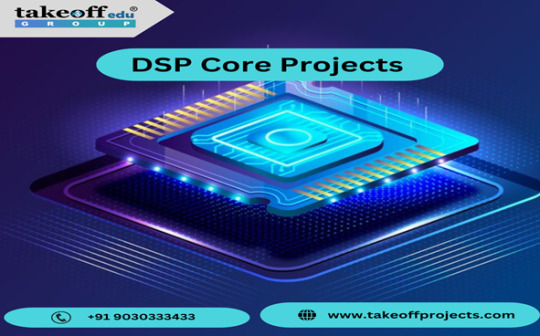
Here are the example titles of DSP Core Projects- Takeoff Projects
Latest
Implementation of Delayed LMS algorithm based Adaptive filter using Verilog HDL
Trendy
Algorithm Level Error Detection in Low Voltage Systolic Array
VLSI Implementation of Turbo Coder for LTE using Verilog HDL
VLSI Implementation of Fully Parallel and CSD FIR Filter Architecture
A High-Speed Floating-Point Multiply-Accumulator Based on FPGAs
High performance IIR filter implementation on FPGA
Standard
An Efficient Parallel DA-Based Fixed-Width Design for Approximate Inner-Product Computation.
Calculator Interface Design in Verilog HDL using MIPS32 Microprocessor.
An Improved Distributed Multiplier-Less Approach for Radix-2 FFT
FPGA Implementation for the Multiplexed and Pipelined Building Blocks of Higher Radix-2k FFT
Low-complexity Continuous-flow Memory-Based FFT Architectures for Real-valued Signals
If there is a picture flattened out, its sharpness could be improved in the project of DSP (Digital signal processing) which would make the photo to look clearer and easier to see the details. These projects are mainly about programming and utilizing software or a specialized physical hardware for the operations of algorithm that process specific frequencies. DSP Core has the potential to be used to solve a wide variety of problems, such as in the fields of communications, medical imaging, and audio processing, and so on. They are instrumental for application of signal polishing and obtaining unique data from the signals, thus simplifying analysis process by rendering it easy to comprehend and work with.
In conclusion, DSP Core projects are essential for many modern technologies, making things like smartphones, music players, and even medical devices work efficiently. Takeoff Edu Group also providing all kind of projects to your Academic years. Through this technology, we can enjoy clearer audio, sharper images, and faster data processing. DSP Core projects play a crucial role in shaping our digital world, enhancing our everyday experiences, and driving innovation forward.
#DSP Memory#Processor core IP#DSP cores Projects#Configurable cores#Configurable processors#DSP core IP core#Digital signal processors
0 notes
Text
niggas are the only ones who can hear Maestro (OG version) TikTok algorithm rn, so heres your fanbase described in little bitch terms
WAKE UP. IT'S A BEAUTIFUL MORNING NIGGAS
JAMAICAN MILEY CYRUS WAKE. UP. IT'S A BEAUTIFUL MORNING MILEY WORLD WICCAS
MORNING MILEY BASTARD JAMAICANS
all the kings horses: heartbreak anthem
WHY IS MY WEIGHT NOT LYING: WOLFGANG AMADEUS AUTOBIOGRAPHY
HOW MANY SUNS DO WE HAVE: GORDON RAMSAY AUTOBIOGRAPHY
WHY IS MY DRESS TELLING ME WHAT TO DO?: FRED SIRIEX AUTOBIOGRAPHY
I CANT EVEN THINK ANYMORE AND I HIT FOR A LIVING: GINO D'CAMPO AUTOBIOGRAPHY
SHIT, I CAN'T TRY WITHOUT PUNCHUATION (HA. NO. NO.): INA GARTEN AUTOBIOGRAPHY
GLEE CAST ARE AFTER MEEEEEEEEEEEEE: JAMIE OLIVER AUTOBIOGRAPHY
#you asshole#the asshole#the musical#high school musical: the musical: the series is your legacy#welcome to bitchtopolis america#location: maine#man#*middle finger in intel core ip processor*
3 notes
·
View notes
Note
QUESTION TWO:
SWITCH BOXES. you said that’s what monitors the connections between systems in the computer cluster, right? I assume it has software of its own but we don’t need to get into that, anyway, I am so curious about this— in really really large buildings full of servers, (like multiplayer game hosting servers, Google basically) how big would that switch box have to be? Do they even need one? Would taking out the switch box on a large system like that just completely crash it all?? While I’m on that note, when it’s really large professional server systems like that, how do THEY connect everything to power sources? Do they string it all together like fairy lights with one big cable, or??? …..the voices……..THE VOICES GRR

I’m acending (autism)
ALRIGHT! I'm starting with this one because the first question that should be answered is what the hell is a server rack?
Once again, long post under cut.
So! The first thing I should get out of the way is what is the difference between a computer and a server. Which, is like asking the difference between a gaming console and a computer. Or better yet, the difference between a gaming computer and a regular everyday PC. Which is... that they are pretty much the same thing! But if you game on a gaming computer, you'll get much better performance than on a standard PC. This is (mostly) because a gaming computer has a whole separate processor dedicated to processing graphics (GPU). A server is different from a PC in the same way, it's just a computer that is specifically built to handle the loads of running an online service. That's why you can run a server off a random PC in your closet, the core components are the same! (So good news about your other question. Short answer, yes! It would be possible to connect the hodgepodge of computers to the sexy server racks upstairs, but I'll get more into that in the next long post)
But if you want to cater to hundreds or thousands of customers, you need the professional stuff. So let's break down what's (most commonly) in a rack setup, starting with the individual units (sometimes referred to just as 'U').
Short version of someone setting one up!
18 fucking hard drives. 2 CPUs. How many sticks of ram???
Holy shit, that's a lot. Now depending on your priorities, the next question is, can we play video games on it? Not directly! This thing doesn't have a GPU so using it to render a video game works, but you won't have sparkly graphics with high frame rate. I'll put some video links at the bottom that goes more into the anatomy of the individual units themselves.

I pulled this screenshot from this video rewiring a server rack! As you can see, there are two switch boxes in this server rack! Each rack gets their own switch box to manage which unit in the rack gets what. So it's not like everything is connected to one massive switch box. You can add more capacity by making it bigger or you can just add another one! And if you take it out then shit is fucked. Communication has been broken, 404 website not found (<- not actually sure if this error will show).
So how do servers talk to one another? Again, I'll get more into that in my next essay response to your questions. But basically, they can talk over the internet the same way that your machine does (each server has their own address known as an IP and routers shoot you at one).
POWER SUPPLY FOR A SERVER RACK (finally back to shit I've learned in class) YOU ARE ASKING IF THEY ARE WIRED TOGETHER IN SERIES OR PARALLEL! The answer is parallel. Look back up at the image above, I've called out the power cables. In fact, watch the video of that guy wiring that rack back together very fast. Everything on the right is power. How are they able to plug everything together like that? Oh god I know too much about this topic do not talk to me about transformers (<- both the electrical type and the giant robots). BASICALLY, in a data center (place with WAY to many servers) the building is literally built with that kind of draw in mind (oh god the power demands of computing, I will write a long essay about that in your other question). Worrying about popping a fuse is only really a thing when plugging in a server into a plug in your house.
Links to useful youtube videos
How does a server work? (great guide in under 20 min)
Rackmount Server Anatomy 101 | A Beginner's Guide (more comprehensive breakdown but an hour long)
DATA CENTRE 101 | DISSECTING a SERVER and its COMPONENTS! (the guy is surrounded by screaming server racks and is close to incomprehensible)
What is a patch panel? (More stuff about switch boxes- HOLY SHIT there's more hardware just for managing the connection???)
Data Center Terminologies (basic breakdown of entire data center)
Networking Equipment Racks - How Do They Work? (very informative)
Funny
#is this even writing advice anymore?#I'd say no#Do I care?#NOPE!#yay! Computer#I eat computers#Guess what! You get an essay for every question!#oh god the amount of shit just to manage one connection#I hope you understand how beautiful the fact that the internet exists and it's even as stable as it is#it's also kind of fucked#couldn't fit a college story into this one#Uhhh one time me and a bunch of friends tried every door in the administrative building on campus at midnight#got into some interesting places#took candy from the office candy bowl#good fun#networking#server racks#servers#server hardware#stem#technology#I love technology#Ask#spark
7 notes
·
View notes
Text
Xenoblade 4 hint from Monolith Soft Recruitment page?


So Monolith Soft announced their RPG recruitment for a while back, and I'm surprised NOBODY has brought this up because I feel this RPG recruitment by Takahashi might give a hint about the project he's actually working on, and especially about the future of the Xenoblade series.
As you can see from the picture, there's a background with a simple gradient color. At first glance, it might not mean anything, right? BUT when you notice the colors of the gradient, they are strikingly similar to the Trinity Processor's color-coding. There's red (Ontos), green (Pneuma), and dark purple (Logos). There's also a hint of dark blue, but I'll elaborate on that later.


First, let’s start with the striking red. The red gradient bears a strong resemblance to Ontos’s core! The palette and gradient feel nearly identical, featuring that distinctive scarlet red with an orange-ish glow.


Next, we have the green, which closely matches Pneuma’s core. The shade leans toward a vibrant emerald green, making the similarity hard to ignore.


Finally, there’s Logos. This one is a bit trickier to spot because the purple is very dark, blending into the dark background and almost camouflaging itself. However, upon closer inspection, the hue is undeniably close to a deep purple, resembling Logos’s core.
Based on this picture, we can speculate that the "RPG" game Takahashi is developing might be Xenoblade 4. Could it focus on the Trinity Processor? It seems plausible, especially considering Takahashi’s comment in the XB3 artbook ~Aionios Moment~, where he mentioned that "he couldn't explain why Malos is in N's sword yet."
Among the Trinity Processor members in the Xenoblade trilogy, Logos is the only one who hasn’t had a game centered around him. Even Xenoblade 3 leaned heavily on Ontos and Pneuma’s stories.
There's also interesting color in the picture that you can see below, there's tiny hint of blue light


I wonder what this could mean. It might not be anything, but let’s take a wild guess.
From Monolith Soft’s 25th Anniversary video and the pictures of their office shared on Twitter, it’s strange how prominently they placed KOS-MOS in the spotlight. Sure, it could just be an homage to their first games, like Xenosaga, but it’s odd that they include KOS-MOS only and not other IPs.
I’m not suggesting we’ll get a Xenosaga remake or Episode 4. Given how Bandai Namco operates these days, that feels like a pipe dream. Contrary to what the fandom thinks, I don’t buy into the theory that Nintendo will buy the IP or fund remakes. That’s not how Nintendo typically operates, especially in their current situation. Plus, Xenosaga has blatant religious references (it literally has actual Jesus as a character & character recites freakin' bible scripture) no way Nintendo would touch that (as evidenced by how some religious references were omitted in Xenoblade 2 localization).
Now, back to the topic. I speculate that this “blue” connection might tie into the blue light falling to Earth in the ending of Future Redeemed (FR). I have a strong feeling that in XB4, we might see a character reminiscent of KOS-MOS 2.0 (basically akin to Saber face in Fates series), Monolith Soft might introduce a female character with blue hair, robotic traits, or a story/personality that nods to KOS-MOS. Alternatively, it could involve remnants of KOS-MOS, like her core or programming, reimagined as a weapon, relic, or machine central to the XB4 story.
If the leaks about Monolith Soft’s new game codenamed ''Project Legacy'' are true, this idea might fit perfectly with the potential XB4 theme: exploring the “legacy” of Klaus and his world. While the Klaus saga might be over, parts of his legacy—like the Trinity Processor and Origin—are still around. Origin especially feels like a magnet for conflict, practically begging for villains to emerge. Someone definitely want to control it.
Reminder FR hinted at space faring humans still existing in Klaus’s world—there are space colonies out there. In the Xeno series, the existence of Earth (a.k.a. Lost Jerusalem) has always been incredibly significant. The FR radio scene essentially confirms that XB’s world is connected to Lost Jerusalem, and the fact that it alludes to space faring humans is pretty important.
“What could this mean?” The next game might delve into the importance of the Conduit (I doubt the Conduit/Zohar is completely gone), space faring humans (!!!), and the Saviorite—artificial humans mentioned in Xenoblade Chronicles 2 and FR (in Xenosaga, it's Realian). The Trinity Processor, Origin, and the mysterious blue light could all play major roles.
So many questions, but these things will definitely be highlights in the next game. I predict the villain might be from space—now that Earth is back, the humans in space might discover it sooner or later.
I’m also sure that Malos/Logos will play an important role! Logos is the only member of the Trinity Processor who hasn’t had his own game or a "human" partner to unlock his potential. The idea of seeing a Logos Ascended form a la Pneuma, possibly an alter ego for Logos/Malos and a Trinity Processor reunion? Gosh, it’s so exciting!
Personally, I hope Xenoblade 4 is set thousands of years after the events of XB3. Frankly, I’d prefer that Mythra’s child doesn’t become the protagonist or even a relevant character, as it might undermine the message of XB3, IMO. Instead, they could establish Mythra’s child as a historical or influential figure—someone whose legacy or actions significantly impact the central conflict in XB4.
I think it would be more interesting if the protagonist of XB4 came from outer space rather than Earth. This could offer a fresh perspective on space faring human society, including their politics, culture, and way of life—something we know very little about. It would also be fascinating to see a protagonist experiencing cultural clashes or value conflicts with the people of Earth. Of course, Malos/Logos should play an important role, perhaps as the protagonist’s “Blade” or companion.
As for the protagonist's gender, I don't bother with it. If it’s a girl, I’d like her to be stoic—different from someone like Shion Xenosaga. Maybe she could be a researcher or an artificial human soldier. If it’s a boy, same with a girl but he's more mentally broken or menhera, to occurring joke that how Malos/Logos is always drawn to edgy, broken men in Japanese meme LOL.
I also want to see Pneuma as a potential antagonist or hostile entity. We’ve already seen other Trinity Processor members (Ontos-Alpha and Logos-Malos) become villain, but Pneuma has yet to take on an evil or antagonistic role. It would be intriguing to explore this side of her, especially since her philosophy and what she represents could make her the most cunning villain among her siblings—something akin to Miang from Xenogears.
Ultimately, I hope this game allows Takahashi to tell the story he’s been envisioning, maybe the ''imagined'' of Perfect Works Episode 6 or Xenosaga Episode 4. And hope we get chaos expy too!
Anyway, thanks for reading my ramblings! Please remember, this is just my analysis and speculation—none of it should be taken as fact. Regardless of what this project turns out to be, I’ll always be excited for Monolith Soft’s games!
#Monolith Soft#Xenoblade#Theory#Speculation#Takahashi Tetsuya#Trinity Processor#Xenoblade 4#Project Legacy#Malos#Logos#Pneuma#Ontos
6 notes
·
View notes
Text

LILYGO T-Deck
T-Deck is a pocket-sized gadget with a 2.8-inch, 320 x 240 pixel IPS LCD display, a mini keyboard, and an ESP32 dual-core processor
7 notes
·
View notes
Text
Anbernic RG35XXSP Review: The greatest clamshell ever?!

The Anbernic RG35XXSP is a retro handheld gaming console that perfectly blends nostalgia with modern technology. As a fan of classic gaming, I was eager to get my hands on this device, and I’m happy to say it doesn’t disappoint.
Design and Build Quality
The first thing you’ll notice about the RG35XXSP is its sleek, compact design. It’s clear that Anbernic took inspiration from the iconic Game Boy Advance SP, but they’ve given it a fresh, modern twist. The clamshell design is both practical and protective, ensuring that the screen stays scratch-free when not in use. The build quality is solid, with a sturdy hinge and a comfortable weight that makes it easy to carry around.
The buttons are responsive and have a satisfying click, which is crucial for any handheld gaming experience. The D-pad is precise, and the face buttons are well-placed, ensuring that even longer gaming sessions remain comfortable. The inclusion of shoulder buttons adds versatility, allowing for a wider range of games to be played effectively.
Display
The 3.5-inch IPS display is one of the standout features of the RG35XXSP. The colors are vibrant, and the viewing angles are excellent. Whether you’re playing in bright sunlight or in a dimly lit room, the screen remains clear and easy on the eyes. The resolution is more than adequate for retro games, making pixel art look sharp and detailed.
Performance
Under the hood, the RG35XXSP is powered by a quad-core processor that handles emulation with ease. I tested a variety of games across different systems, including NES, SNES, GBA, and even some PS1 titles, and the performance was consistently smooth. Load times are quick, and I didn’t encounter any noticeable lag or frame drops, even in more demanding games.
Firmware and User Options
One of the key strengths of the Anbernic RG35XXSP is its flexible firmware options. Out of the box, the device comes with a well-optimized custom Linux-based firmware that offers a user-friendly interface and reliable performance. However, for users who like to tinker, there are several alternative firmware options available that can enhance and customize the gaming experience.
Popular community-driven firmware options such as muOS and MinUi are compatible with the RG35XXSP, providing additional features, better emulator performance, and more customization options. These alternative firmware packages are relatively easy to install and offer significant improvements in terms of user interface, game management, and even additional system support.
Users can also access a variety of settings directly through the stock firmware, including screen scaling options, aspect ratio adjustments, and save state management. The ability to map buttons and adjust control schemes is another strong point, giving players the freedom to tailor the gaming experience to their preferences.
For those interested in expanding the device’s capabilities, custom firmware opens the door to a broader range of emulators, better system compatibility, and even the ability to run indie games and homebrew applications. This makes the RG35XXSP not just a retro gaming device but a versatile handheld that can grow with you as you explore its full potential.
Battery Life
Battery life is always a concern with handheld devices, but the RG35XXSP delivers impressive longevity. On a full charge, I was able to get around 5-6 hours of continuous gameplay, depending on the system and screen brightness. Charging via USB-C is fast and convenient, and the battery indicator provides a clear readout, so you’ll always know when it’s time to recharge.
Audio
The built-in speakers are decent, offering clear sound that’s loud enough for most environments. However, for the best experience, I recommend using headphones. The audio quality through the 3.5mm jack is excellent, with no noticeable interference or static, which enhances the overall gaming experience.
Final Thoughts
The Anbernic RG35XXSP is a fantastic retro handheld that delivers on its promises. It’s a device that appeals to both nostalgic gamers and those new to retro gaming. With its impressive build quality, vibrant display, smooth performance, and flexible firmware options, it’s hard to find any major faults with this console.
Whether you’re reliving your favorite childhood games or exploring classics for the first time, the RG35XXSP is a worthy companion. Anbernic has once again proven that they understand what retro gamers want, and they’ve delivered a product that not only meets but exceeds expectations.
4 notes
·
View notes
Text
Lenovo 300e Gen 4 Perfect Chromebook for Students
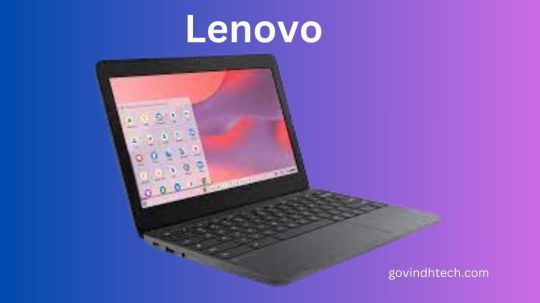
Lenovo 300e Gen 4
With the 300e Gen 4, MediaTek and the Lenovo deliver smarter learning. Lenovo’s next-generation educational Chromebooks use MediaTek. Kompanio processors from MediaTek make these devices suitable for students and teachers.
Security, device management, and Kompanio-powered Chromebooks like the Lenovo 300e Gen 4 are included in the Lenovo MediaTek Chromebook Education school package.
Powerful, versatile digital tools enable in-class and out-of-class learning. Because gadgets work well, teachers can easily set up and supervise classes. This sets schools up for years of success.
Chromebooks with MediaTek Kompanio MediaTek Kompanio is the trustworthy and innovative do-anywhere companion chip that enhances Chromebook experiences for classroom or remote education, business demands, streaming entertainment, video conferencing, and creative.
Device manufactures can only produce excellent Chromebooks on MediaTek Kompanio platforms.. These powerful, all-in-one chips combine AI processors, HDR cameras, fast and reliable Wi-Fi connectivity, and ultra-efficient performance for true, innovative mobile computer devices with an all-day battery life that can open, flip, fold, or separate.
What benefits Chromebooks from MediaTek? With a reputation of delivering innovative, always connected, and highly efficient Android smartphone and tablet platforms, MediaTek has developed a range of powerful Chromebook SoCs since 2016.
Chromebooks combine cloud and edge experiences for anywhere computing, including work, education, video conferencing, social, shopping, streaming entertainment, and more.
Top Features & Performance MediaTek Chromebook chips combine powerful and energy-efficient Arm octa-core CPUs and many-core the GPUs, MediaTek-designed AI processors, premium FullHD-to-4K displays, high-resolution cameras, and the latest Wi-Fi and Bluetooth technologies to deliver amazing Chromebook experiences. Highly responsive apps, multitasking, and stable connectivity.
Enhanced Battery Life Our Chromebooks are battery-efficient and powerful. The highly integrated design, power-efficiency advancements, and top manufacturing practices ensure your Chromebook lasts as long as you need it.
Lenovo 300e Chromebook Gen 4 MediaTek Kompanio 520 ChromeOS ARM Mali-G52 2EE MC2 GPU LPDDR4x-3600, 8GB soldered Systemsboard 64GB eMMC 5.1 Lenovo Chromebook 300e gen 4 Lenovo’s 300e Yoga Chromebook Gen 4 (11.6″ model) is strong, simple to use, and equipped to grow alongside kids as they meet their learning objectives. With its lightweight, convertible design, efficient MediaTek Kompanio 500 Series CPUs, integrated graphics, and user-friendly ChromeOS platform, this device is designed to facilitate the development of relationships between teachers and students both within and outside of the classroom.
This cutting-edge educational tool is designed for the future of learning with features including a 360-degree Sync hinge, snappy touch panel, optional garaged USI 2.0 Stylus, extended battery life, and an optional 5MP world-facing camera. Whether studying in the classroom or at the kitchen table, students can benefit from quicker connectivity when conducting research for assignments, viewing lectures, and exchanging documents thanks to Wi-Fi 6.
Elevated-Performance Education By fusing the intuitive ChromeOS platform with the effective and stress-free mobile computing experience of the MediaTek Kompanio 500 Series Processor, the Lenovo 300e Gen 4 makes modern learning possible. The 11.6-inch HD IPS touch display’s 360-degree Sync hinge enables smooth switching between use modes for reading, writing, drawing, content creation, and presenting. Its tactile sensation piques the imagination.
A student-friendly encounter
The Lenovo 300e Gen 4 has an anti-scratch fabric-like cover texture, enhanced Waves Audio for brighter sound, a sharp HD camera, and an optional 5MP world-facing camera. It is designed to spark creativity from anywhere with Wi-Fi 6. The tough-as-nails display with Corning Gorilla Glass protects the display from the daily wear and tear of everywhere learning, while the innovative top-load keyboard offers easy serviceability.
HARDY TECHNOLOGY The Lenovo 300e Gen 4 is designed to withstand bumps and bruises from the hybrid learning environment because of the new DuraSpec testing standards. The keyboard can withstand unintentional spills up to 360 ml thanks to its anti-pry full-skirt keycaps. Additionally, this durable equipment is portable to any classroom during class hours thanks to its reinforced ports and hinges, A-cover force of 60 kg, rubber bumpers, and a drop test into concrete of 76 cm.
Lenovo 300e Yoga Chromebook Gen 4 Stylus
Teachers and kids are protected from cyberthreats by the Lenovo 300e Yoga Chromebook Gen 4’s integrated end-to-end security, which includes a webcam privacy shutter. Additionally, ChromeOS shields users with safe surfing, sandboxing, and the Titan C security chip from Google in addition to routine automatic security updates that run in the background, meaning you never have to stop learning.
Lenovo 300e Yoga Chromebook gen 4 Services
Lenovo provides a wide range of end-to-end services to safeguard and support your investment, allowing you to concentrate on your studies rather than IT.
Enrollment in ChromeOS Zero-Touch Provide staff with the appropriate devices while maintaining endpoint security, introducing new cloud-based applications, and overseeing overworked support desks. Lenovo and Google’s zero-touch enrollment enables auto-registration and remote deployment, with devices being shipped straight to users.
Protection Against Accidental Damage Reduce the amount of time students must miss from school and safeguard your equipment from harm not covered by the guarantee with limitless repairs in the case of inadvertent accidents. Lenovo Qualified parts and extensive diagnostic equipment are used by Lenovo-trained personnel to perform Accidental Damage Protection.
SERVICES FOR CO OFFSET Customers can offset the carbon emissions linked to their Lenovo products as an easy and transparent method to support the environment. Lenovo has computed the carbon footprint of its personal computers at every stage of their life from production and delivery to use and disposal. Lenovo’s carbon offset partner purchases carbon offset credits based on the device’s calculated emissions and contributes them to various United Nations climate action projects.
Read more on Govindhtech.com
3 notes
·
View notes
Text
Acer Chromebook Spin 714
Processor: Intel Core i5-10210U
Memory: 8GB DDR4 RAM
Storage: 128GB PCIe NVMe SSD
Display: 14-inch Full HD IPS touchscreen
Convertible Design: 360-degree hinge
Battery Life: Up to 12 hours
Operating System: Chrome OS
Connectivity: Wi-Fi 6, Bluetooth 5.0, USB Type-C, USB 3.1, HDMI, microSD card reader
Build: Aluminum chassis
Security Features: Fingerprint reader, Titan C security chip Read more..
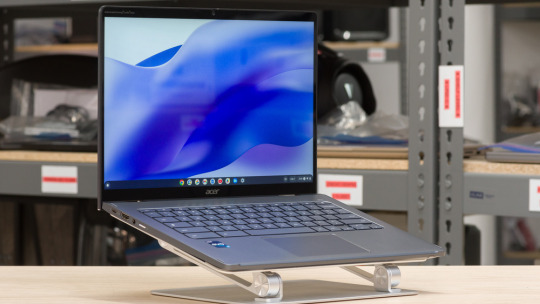
2 notes
·
View notes
Text
Acer Aspire 3 A314-23P-R3QA Slim Laptop.
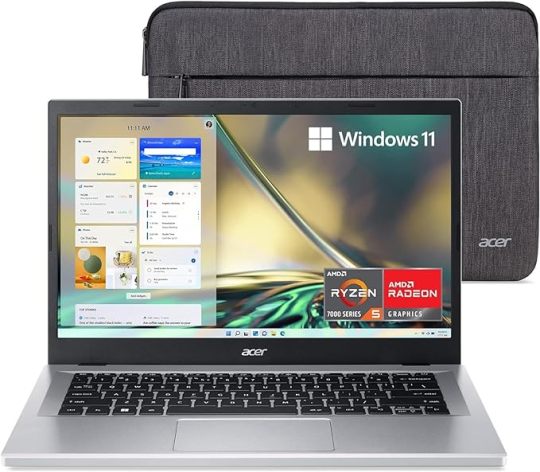
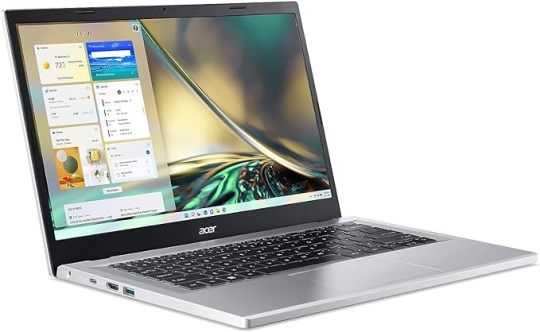
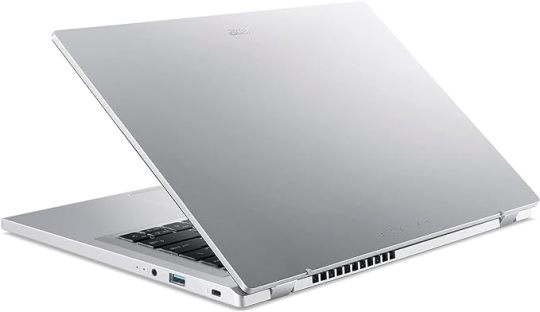
Acer Aspire 3 A314-23P-R3QA Slim Laptop.14.0" Full HD IPS Display. AMD Ryzen 5 7520U Quad-Core Processor. AMD Radeon Graphics | 8GB LPDDR5. 512GB NVMe SSD. Wi-Fi 6 | Windows 11 Home,Silver : Electronics.
#laptop#acer laptop#best laptop#acer nice laptop#quality laptop#welcome home#super mario#ryan gosling#succession#ted lasso
2 notes
·
View notes
Text

ASUS TUF Gaming F15 : Unleash Your Gaming Potential with Power and Precision. Original price : USD 999.99 Now price : USD 799.00 Featured brands | Shipped within 72 hrs | Free returns. Check the Link for more info : https://amzn.to/3ONMTjV Elevate your gaming experience with the ASUS TUF Gaming F15 Gaming Laptop. Featuring a 15.6-inch 144Hz FHD IPS-Type display, an Intel Core i5-11400H processor, a GeForce RTX 3050 Ti graphics card, and a host of high-performance features, this laptop delivers immersive visuals, powerful processing, and smooth gameplay. With 16GB DDR4 RAM, a 512GB PCIe SSD, Wi-Fi 6 connectivity, and Windows 11 Home, the ASUS TUF Gaming F15 is built to take your gaming to the next level.
2 notes
·
View notes
Note
i return with computers - aimed for 15.6in screens for your mole eyes. idk if you've ever used backmarket so just gonna say that I have and I'd say its pretty trustworthy. not sure if all of them are backlit but thats a pretty standard thing for a computer to have so I feel like they should be. good portion are refurbished
https://www.walmart.com/ip/Recertified-Dell-Precision-M7520-7520-15-6-FHD-Intel-Core-i7-6820HQ-2-7GHz-32GB-RAM-512GB-SSD-NVIDIA-Quadro-M2200-Windows-10-Pro/450982289?wmlspartner=wlpa&selectedSellerId=8537 ($299.99)
https://www.amazon.com/Lenovo-ThinkPad-Laptop-i5-6300U-Processor/dp/B08P8CN7RQ?source=ps-sl-shoppingads-lpcontext&ref_=fplfs&psc=1&smid=A3P65HVUXSSTGQ ($198.00)
https://www.amazon.com/Dell-Latitude-i5-6300U-Certified-Refurbished/dp/B07GCRW5BM?source=ps-sl-shoppingads-lpcontext&ref_=fplfs&psc=1&smid=ALMHD3AEFM8ST ($180.19)
https://www.backmarket.com/en-us/p/dell-precision-m7520-156-inch-intel-16-gb-ssd-512-gb/d7a604ac-87dc-4a54-8cfb-72b213214479#l=11 ($299.99)
https://www.backmarket.com/en-us/p/dell-latitude-e6540-156-inch-4600m-16-gb-ssd-512-gb/5921ead5-ab00-4b35-b120-9cdd47641f78#l=11 ($242.00)
https://www.backmarket.com/en-us/p/dell-latitude-5580-15-inch-7300u-16-gb-512-gb-ssd/32808f5d-e0ff-4dec-9622-ee2d8b885cef#l=11 ($219-$229, depending on quality chosen)
https://www.amazon.com/Dell-Latitude-i5-6300U-Windows-Renewed/dp/B0C5RFWJ32?source=ps-sl-shoppingads-lpcontext&ref_=fplfs&psc=1&smid=ASGCWNDQR56IK ($199)
If you look through 'em and decide you don't like any, I personally recommend Google Shopping or Backmarket for searching since they have the best filtering imo, Amazon is mid but tolerable for filtering
-Nina simp
This is so helpful! Thank you!! Im gonna be doing research on these and backmarket over the next few days-- I can't buy anything rn bc my dog broke my debit card 🤭 I appreciate your help :33
2 notes
·
View notes
Text
Motorola razr 40 launched in india at Rs.59000 for base variant
Motorola has launched the new moto razr 40 smartphone in India. The phone comes with large 6.9 inch oled foldable screen with 165Hz refresh rate. It has powered by snapdragon 7gen 1 SoC. Also has 8GB of RAM and 256GB UFS 2.2 storage. & Sage Green, Vanilla Cream, Summer Lilac color options.
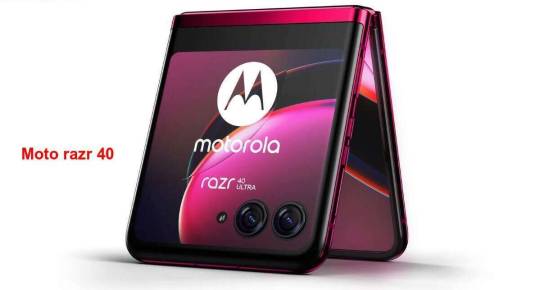
CAMERA-
The phone has 64MP main camera with 1.7 aperture, OIS, 13MP ultra-wide camera, macro option, f/2.2 aperture and 32mp camera front facing camera.
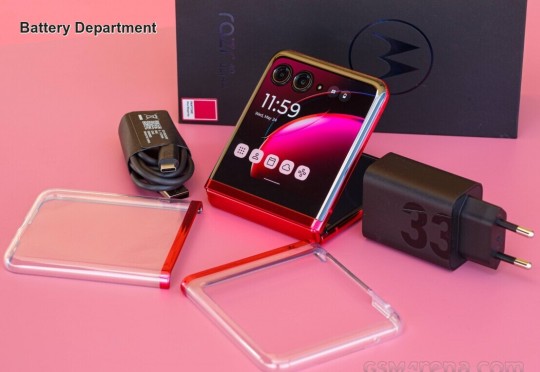
Software & UI-
This smartphone running with android 13 Tiramisu with MyUX 4.0 custom skin
CONNECTIVITY-
Supported Networks - 5G/4G/3G/2G
SIM Slots - Dual (nano)
Bluetooth - v5.3
Wi-Fi - Wi-Fi 6E
USB Port - USB Type-C
NFC Chip - Yes
Supported GPS - Dual Band GPS, AGPS, GLONASS
BATTERY-
Battery Capacity (mAh) - 4200
Fast Charging - Yes
Charging Speed - 30W
Wireless Charging - true
Wireless Charging Speed - 5W
Reverse Charging - No
Extra Features
3.5 mm Audio Jack - No
Set of Speakers - stereo
Face Unlock - yes
Fingerprint Reader - Side Mounted
IR Blaster - no
Sensors - Ambient Light, Fingerprint, Gyroscope, Light Sensor, Proximity
IP rating - IP52
PERFORMANCE-
Processor - Octa Core Snapdragon 7 Gen 1 5nm Mobile Platform with Adreno 730 GPU
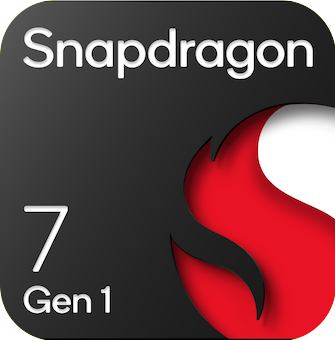
Memory - 8GB LPDDR5 RAM, 256GB UFS 2.2 storage

Pricing & Availability -
The price of the phone is Rs.59,999 and it is available on Amazon.com
PROS & CONS -
Pros:-
4K video recording support with video stabilization.
Amazing chipset performance for gaming and multitasking.
Latest Android 13 OS support.
Foldable LTPO AMOLED display with 144Hz refresh rate.
AMOLED cover screen with 1000 nits brightness.
NFC and 5G enabled smartphone.
The cover screen comes with gorilla glass protection.
Comes with 30W fast wired and 5W wireless charging support.
Stereo speakers are present.
Cons :-
Without Reverse charging support.
An optical zoom camera is missing.
Without any micro sd card slot.
An audio jack is not present.
Without custom UI.
Average battery capacity.
2 notes
·
View notes
Text
Asus Unveils Refreshed Vivobook S16, S16 OLED Laptops in India Alongside Vivobook S14: Price, Features
Asus on Tuesday announced a refreshed lineup of Vivobook laptops in India. As part of the upgraded Vivobook series, the company has introduced four models. The Asus Vivobook S16 OLED is an AI PC, powered by up to an Intel Core Ultra 7 processor. It comes with up to a 16-inch OLED panel with 60Hz refresh rate. Then there’s the standard Vivobook S16, which gets a 16-inch IPS panel with the 144Hz…
0 notes
Text
Price: [price_with_discount] (as of [price_update_date] - Details) [ad_1] From the manufacturer Resolution: FHD (1920 x 1080) | Refresh Rate: 60 Hertz | Viewing Angle: 178 degrees Connectivity: 2 HDMI ports to connect set top box, Blu Ray players, gaming console | 2 USB ports to connect hard drives & other USB devices | 1 Optical Output to connect high end soundbars, speakers | Wifi | LAN (Ethernet) Sound : 24 Watts Output | Stereo Surround Sound with Box Speakers | 5 Sound Modes Smart TV Features : Prime Video, Hotstar, Netflix, Zee5 and more | Quantum Lucent Technology | PC Connectivity | Playwall | Quad Core Processor | Screen Mirroring | Cloud TV | Movie Box Display: A+ Grade Panel | IPE Technology | True Colour | Frameless Design | Quantum Lucent Technology [ad_2]
0 notes
Text
HP Pavilion27-Inch Full HD IPS LED Monitor
A groundbreaking Retina display. Powerful dual-core and quad-core Intel processors. Fast flash storage. High-performance graphics. Great built-in apps. And now in the 13-inch model, a revolutionary new Force Touch trackpad and even longer battery life.1 Whatever you can imagine, MacBook Pro with Retina display gives you the power to create. The design of MacBook Pro packs a lot of power into not…
0 notes